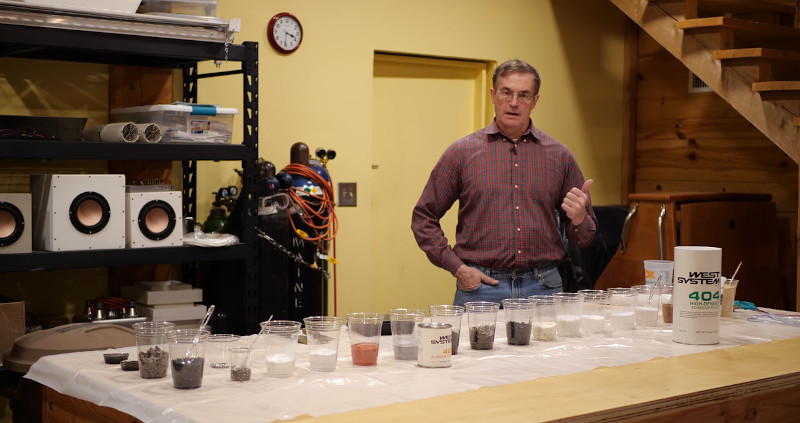Epoxy resins are an important material in many fields. Used on their own as an adhesive, used as a coating, or used in concert with fiber materials to make composites, their high strength and light weight makes them useful in many applications. [Tech Ingredients] decided to explore how combining basic epoxy resin with various additives can make it perform better in different roles.
The video primarily concerns itself with explaining different common additives to epoxy resin mixtures, and how they impact its performance. Adding wood flour is a great way to thicken epoxy, allowing it to form a bead when joining two surfaces. Microbeads are great to add if you’re looking to create a sandable filler. Other additive like metal powders lend the mixture resistance to degradation from UV light, while adding dendritic copper creates a final product with high thermal conductivity.
The video does a great job of not only explaining the additives and their applications, but also shares a few handy tips on best workshop practices. Things like triple-gloving and observing proper mixing order can make a big difference to your workflow and lead to better results.
We’ve seen practical applications of epoxy mixes before – with epoxy granite being a particularly popular material. Video after the break.
















Next video after this is even better, thermal epoxies!!
Have been looking for ground marble. As lots of good but heavy electrical insulators used to be made from marble loaded epoxy. Not good for drilling holes in – for the drill bit at least.
Al2O3 “aluminium oxide” powder -basically ceramic dust- used for sandblasting is readily avaivable and cheap. It’s cheap, electrically isolating and thermally conductive.
Good idea. I’ve been looking for a thermally conductive but electrically insulating filler too. Aluminium Nitride seemed hard to get and Boron Nitride is too expensive. There’s always diamonds…
Be wary of crystalline thermal conductives, some only conduct well in one plane.
Resin bound stone (marble?) powder is commercially available in all kinds of sheets. It is used for furniture such as tables and for counters in butcher shops where it is easy to clean and has a very long life with little wear.
If you want to make your own, research “ball mill”. It’s basically a big bucket full of chunks which is rotated constantly and the chunks wear each other out.
A well known you-tuber chemist, Toby, Torby, … forgot his name, used it to make aluminum powder to make thermite.
And large scale ball mills and tumblers can be made out of concrete mixers. granite chips are sold in the outdoor section of most hardware stores.
It should be noted that the “ball” in “ball mill” is a reference to the actual balls that are placed in with the material and are what bring about most of the crushing of the material.
Good luck with that, granites vary, but some can be harder than steel, so you could end up with a nice batch of gritty iron filings.
the ball bearings are heat treated…and even if they’re softer, they still work as miniature hammers…
If you just want a small quantity, rather than building your own ball mill, you can buy a bottle of dolomite powder at your local healthfood store. It’s available as a “dietary supplement” because some people think it’s a good idea to eat it.
Great video, very precise and explained, well done
Excellent information, clearly and thoroughly presented. I am a sculptor that has been using cement mixes and am now seeing , experimenting with making epoxy Clay’s as a more lightweight alternative. Ceramic suppliers will also have interesting additive options. Thank you for the video.